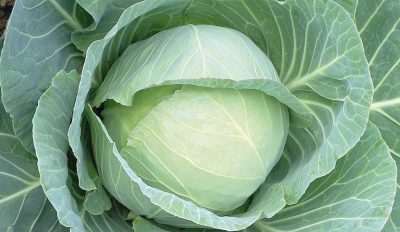
- Authors: Maksimov S.V., Klimenko N.N., Kostenko G.A., Kiseleva I.K.
- Year of approval: 2011
- Appointment: for fresh consumption, for fermentation, for all types of processing
- Leaf rosette: raised
- Leaf size: medium size
- Leaf color: green
- Sheet surface: smooth
- Outside stump: short
- Internal stump: short
- Weight, kg: 1,7-2,2
Experienced vegetable growers and summer residents highly appreciate cabbage varieties, which are characterized by disease resistance, good productivity and unpretentious agricultural technology. These include a mid-season hybrid of white cabbage Countess, bred by Russian scientists.
Breeding history
Cabbage Countess is a hybrid of the first generation, created by a group of breeders of the Poisk agricultural firm in 2009. Authorship belongs to S.V. Maksimov, N.N. Klimenko, G.A.Kostenko and I.K. Cabbage is grown mainly in open ground - garden ridges, fields, farmland. In addition, cabbage is grown with pleasure on the territory of Ukraine and Moldova.
Description of the variety
White cabbage is a compact plant with a raised rosette of leaves. The culture is characterized by an average length of foliage that grows up to 35-45 cm, which have a smooth surface, barely noticeable venation, a uniform bright green cover and slightly wavy edges. The shape of the leaf plate is unusual - broadly elliptical.
Characteristics of the appearance of the plant and heads of cabbage
Hybrid Countess ripens even and neat, which attracts the attention of farmers who grow crops on an industrial scale. The average weight of cabbages is 1.7-2.2 kilograms. The cabbage has a rounded shape. The diameter of the forks is average. The structure of the heads is dense, closed. Outside, the vegetable has a gray-green color, and inside the cabbage is whitish. Both the outer and inner stumps of the vegetable are shortened, but dense.
Ripe heads of cabbage can easily be transported over long distances, and can also be stored for a short time in a cool place. Only neatly cut heads are endowed with an average keeping quality. Cabbage heads do not crack during storage.
Purpose and taste
Cabbage tastes great. Its pulp is juicy, crunchy, without wateriness and fiber. The taste contains a slight sweetness and a pleasant refreshing aroma. There is no bitterness in the vegetable. The crunch persists even after heat treatment.
The purpose of cabbage is universal - it is stewed, added to cold and hot dishes, pickled, fermented, and it is also ideal for fresh vegetable salads.
Ripening terms
The Countess belongs to mid-season cabbage varieties. The period from the emergence of mass seedlings to the maturation of the heads of cabbage takes only 125-135 days. Having transplanted the seedlings to a permanent place, after 80-85 days you can taste crispy cabbage. Vegetables ripen together. The harvest period is between August and October.
Yield
The hybrid gives good yields if the vegetable crop is given basic care. On average, 6-8 kg of cabbage heads are removed from 1 m2. On an industrial scale, average yields are also pleasing - 250-520 c / ha. The maximum yield is recorded at around 599 c / ha.
Growing and caring
The vegetable is cultivated mainly through seedlings.Sowing seeds for seedlings is carried out from late March to early April. For transplantation to a permanent place of growth, mature bushes at the age of 40-45 days with 5-7 true leaves are suitable. Planting is carried out according to the scheme 60x60 cm. Up to 3 plants are placed per 1 m2. Pumpkin and legumes, onions and greens are considered excellent precursors for the Countess white cabbage.
Caring for cabbage includes basic measures: watering with warm water every 3-4 days, applying complex fertilizers three times per season (the plant reacts well to mineral complexes), loosening and weeding the soil after each watering, hilling bushes (enough once), preventing diseases and invasion of pests.

To grow a rich cabbage crop, you need to know when and how to plant this crop outdoors. Planting dates are determined depending on the variety. It is also necessary to properly prepare the soil and follow the rules of crop rotation.


Soil requirements
The culture has no special requirements for the soil. Cabbage prefers to grow and develop on light, fluffy, fertile, moisture and air permeable soils. It is important that the soil is neutral or low acidity. It is also worth noting that cabbage does not grow on swampy and heavy soils.

Cabbage requires particularly careful care when growing. The plant quickly absorbs nutrients, so the soil needs to be enriched regularly. Adequate amounts of minerals, organics and nitrogen must be provided. Some products can be purchased at the store, while others are easy to make at home.
Required climatic conditions
Despite the fact that the Countess is a hybrid with good stress resistance, due to which it easily tolerates temperature extremes, short drought and shade, the site for cabbage should be sunny and bright, protected from gusty winds.
Disease and pest resistance
The vegetable's immune system is good, providing protection against many fungal diseases. Cabbage is resistant to fusarium wilt and is also tolerant to bacteriosis. Sometimes a vegetable can be attacked by harmful insects - aphids, cabbage flies, fleas, slugs, which will help to get rid of timely spraying with insecticidal preparations.

Cabbage is a very popular horticultural crop. But growing a good, large and tasty cabbage is sometimes very difficult, because it is often affected by a huge number of diseases and pests. The main role in the cultivation of this vegetable is played by regular prevention, which helps to get a rich harvest, and prevent the occurrence of diseases and the invasion of harmful insects. It is very important to start treatment as early as possible, otherwise there is a risk of spreading the infection to unaffected plants.























































































